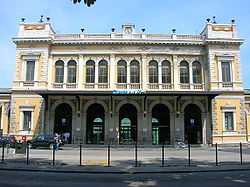Novara railway station
| Novara | |
 | |
|---|---|
| Main entrance to the passenger building. | |
| Location | |
| Address | Piazza Garibaldi 28100 Novara NO |
| Comune | Novara |
| Province | Novara |
| Region | Piedmont |
| Country | Italy |
| Coordinates | 45°27′03″N 08°37′31″E / 45.45083°N 8.62528°ECoordinates: 45°27′03″N 08°37′31″E / 45.45083°N 8.62528°E |
| Line(s) | Turin–Milan Arona–Novara Novara–Alessandria Biella–Novara Varallo–Novara Novara–Gozzano–Domodossola |
| Distance | 98.940 km (61.478 mi) from Torino Porta Nuova |
| Other information | |
| Opened | 3 July 1854 |
| Platforms | 13 |
| Manager | Rete Ferroviaria Italiana Centostazioni |
| Line operator(s) | Trenitalia, Trenord, SNCF |
| Classification | Gold |
| Services | |
| | |
| Connections | |
| Regional Interurban Milan Malpensa Airport | |
| Location map | |
 Novara railway station (Northern Italy)
| |
Novara railway station (Italian: Stazione di Novara) is the main station serving the city and comune of Novara, in the Piedmont region, northwestern Italy. Opened in 1854, it forms part of the Turin–Milan and is origin of the lines to Arona, to Alessandria, to Biella, Varallo, Domodossola and Luino, respectively.
The station is currently managed by Rete Ferroviaria Italiana (RFI). However, the commercial area of the passenger building is managed by Centostazioni. Train services are operated by Trenitalia. Each of these companies is a subsidiary of Ferrovie dello Stato (FS), Italy's state-owned rail company.
A second station, the Novara Nord railway station, is located a short distance away, and serves as the terminus of the Saronno–Novara railway, which is owned by FNM SpA. That line is managed by FERROVIENORD, and train services on it are operated by LeNORD, each of those companies being a member of the FNM group.
Location
Novara railway station is situated at Piazza Garibaldi, at the northeastern edge of the city centre.
History
The station was opened on 3 July 1854, upon the opening of the Novara–-Mortara portion of the Arona–Alessandria railway.[1]
Features
The passenger station is equipped with fifteen tracks and passing loops, of which thirteen (10 platform and three loops, and 2 north and 1 south) are numbered for passenger service. Track 1 and the tracks of the first three platforms (2-3, 4-4A-5, and 6-6A-6B-7) are served directly from the subway and have a roof, though not for its entire length. The last three tracks are accessible from the platform of the tracks 6 and 7 with a track level crossing. Tracks 3 and 4 serve the Turin–Milan railway, while other tracks are mostly used by trains on the other, terminating, lines.
The goods yard is distinctly separated from the passenger station and is linked to the incoming lines by two lines connected in a triangle, starting from one end of the passenger station. This allows the goods yard to receive goods trains without having to occupy sections of line reserved for passenger services. At the end of the goods yard is the Centro Intermodale Merci (CIM), built at the turn of the twenty first century, while along the track north of the triangle is the new Novara Nord railway station. Finally, the goods yard is linked with the Treno Alta Velocità (TAV) by a couple of tracks that are bypassed by the FNM line to Novara Nord.
Passenger and train movements
The station has about 9.4 million passenger movements each year, making it the seventh busiest Centostazioni station in terms of passenger movements.[2] There are about 350 trains per day, including any Trenitalia train replacement buses.
Trains stopping at Novara include EuroCity, Eurostar Italia, EuroNight and regional trains, along with line S6 on the Milan suburban rail service. The most important domestic destinations of these trains are Turin, Milan and Venice, but passengers also depart for and arrive from other domestic destinations, such as Genoa, Biella and Vercelli. The main international links are with Paris and Barcelona.
Many of the station's passenger movements are arrivals from neighboring cities, with a large presence of students in the morning. However, the predominant component is commuter traffic to Milan, and, to a lesser extent, Turin. This traffic leads to overflowing commuter trains, even though each of them is made up of twelve carriages. Combined with the many and repeated delays, the uncomfortable travelling conditions have led to numerous protest actions, with resonance at the national level.
Goods traffic, which is also significant, is characterized by the presence of the CIM and a related rolling highway to northern Europe. Even the passage of goods trains in transit is not negligible.
Services
| Preceding station | SNCF | Following station | ||
|---|---|---|---|---|
toward Paris-Lyon |
TGV | Terminus |
See also
- History of rail transport in Italy
- List of railway stations in Piedmont
- Rail transport in Italy
- Railway stations in Italy
References
- ↑ Alessandro Tuzza and others. "Prospetto cronologico dei tratti di ferrovia aperti all'esercizio dal 1839 al 31 dicembre 1926" [Chronological overview of the features of the railways opened between 1839 and 31 December 1926]. Trenidicarta.it. Alessandro Tuzza. Retrieved 26 November 2010. (Italian)
- ↑ "Flussi Annui nelle 103 Stazioni" [Annual flows at the 103 stations]. Centostazioni website. Centostazioni. Retrieved 13 December 2010. (Italian)
External links
![]() Media related to Novara railway station at Wikimedia Commons
Media related to Novara railway station at Wikimedia Commons
| Preceding station | Milan suburban railway service | Following station | ||
|---|---|---|---|---|
| Terminus | Trenord S6 |
toward Treviglio |
| |||||||||||||
